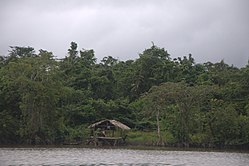| Waini River | |
|---|---|
 | |
| Location | |
| Country | Guyana [1] |
| Region | Barima-Waini |
| Physical characteristics | |
| Source | |
| • location | [1] [2] |
| • coordinates | 7°00′N59°24′W / 7.0°N 59.4°W |
| Mouth | Atlantic Ocean |
• location | Waini Point [1] [3] |
• coordinates | 8°23′25″N59°50′14″W / 8.390186°N 59.837208°W |
• elevation | Sea level [1] |
| Basin features | |
| Tributaries | |
| • left | "Left" is in the sense source to mouth but tributaries are listed mouth to source [1] Mora Passage Warapoko Sabaina River Arasika Barama River (Village of Santa Cruz) Kumanaballi Matorohana Anaida Arawatta Ananu Two Mouth Ariaparu Pelibelimba Turubang Yamira Durabanna Imotai Kasipang Source of Waini River. |
| • right | "Right" is in the sense source to mouth but tributaries are listed mouth to source [1] [4] Thunder Creek Kuberina Mokaboina Luri Baramanni Barukabaru Kumaruwa Kuniaballi (Village of Santa Cruz) Sirikata River Kuiaru River Mubohina River Kwabanna Kwassi Anapari Akabaru Mariwaru Urabubaru Potawau Turtle Shararin Arawapai Source of Waini River. |
The Waini River is a river in the Barima-Waini region of northern Guyana. It flows into the Atlantic Ocean. The upper portion of the river flows through the Guianian moist forests, while the lower Waini river flows through the eastern extent of the vast Orinoco Delta swamp forests before emptying into the sea.
